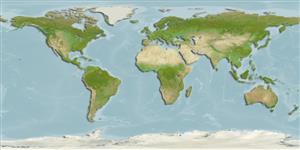Klassifizierung / Names
Namen | Synonyme | Catalog of Fishes(Gattung, Arten) | ITIS | CoL | WoRMS | Cloffa
>
Pleuronectiformes (Flatfishes) >
Bothidae (Lefteye flounders)
Etymology: Monolene: Greek, monos = one + Greek, lenos, ou = cavity in the skull (Ref. 45335).
Eponymy: The succession of Danish research vessels named ‘Dana’ seem to have been greatly favoured by describers of fish, and often the etymology includes: “…from which the holotype was collected. [...] (Ref. 128868), visit book page.
Environment: milieu / climate zone / depth range / distribution range
Ökologie
seewasser bathydemersal; tiefenbereich 300 - 400 m (Ref. 58018). Deep-water
Eastern Pacific.
Size / Gewicht / Alter
Maturity: Lm ? range ? - ? cm
Life cycle and mating behavior
Geschlechtsreife | Fortpflanzung | Ablaichen | Eier | Fecundity | Larven
Amaoka, K. and H. Imamura, 2000. A new flounder, Monolene helenensis (Pleuronectiformes: Bothidae) from the eastern tropical Atlantic. Ichthyol. Res. 47(3):243-247. (Ref. 37941)
IUCN Rote Liste Status (Ref. 130435: Version 2024-1)
Bedrohung für Menschen
Harmless
Nutzung durch Menschen
Tools
Zusatzinformationen
Download XML
Internet Quellen
Estimates based on models
Phylogenetic diversity index (Ref.
82804): PD
50 = 0.5005 [Uniqueness, from 0.5 = low to 2.0 = high].
Bayesian length-weight: a=0.00912 (0.00408 - 0.02036), b=3.04 (2.85 - 3.23), in cm total length, based on LWR estimates for this (Sub)family-body shape (Ref.
93245).
Trophic level (Ref.
69278): 3.5 ±0.4 se; based on size and trophs of closest relatives
Widerstandsfähigkeit (Ref.
120179): mittel, Verdopplung der Population dauert 1,4 - 4,4 Jahre. (Preliminary K or Fecundity.).
Fishing Vulnerability (Ref.
59153): Low vulnerability (10 of 100).
